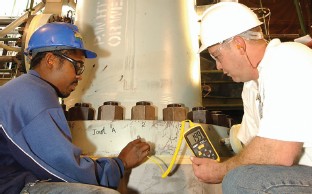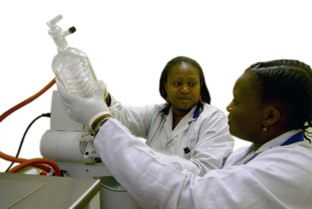|
|
| |
| |
| safety & environment |
| |
| The PBMR has inherently safe characteristics as a result of the |
- Design
- Materials used
- Fuel and
- Physics involved
|
| |
| This is why, should a worst-case scenario occur, no human
intervention is required in the short or medium term. |
| |
| In all existing power reactors, safety objectives are achieved by
means of custom-engineered, active safety systems. |
| |
| Why do PBMRs behave differently from other
nuclear reactors in crises? |
| Nuclear accidents are principally driven by too much heat. This
surplus or residual heat is called decay heat and is caused by
radioactive decay of fission products. Put simply, if you do not cool
the reactor sufficiently, the heat will cause the nuclear fuel to
release radioactivity that cannot be contained. |
| |
| In "conventional" reactors, heat is removed by active cooling
systems (such as pumps), which rely on the presence of coolant such as
water. Any such system may fail and therefore they are duplicated in
conventional reactors to make sure that there will be support, should
the first line of defence fail. Secondly, so-called containment
buildings are constructed which is nothing less than strongly armoured
containers to create a barrier to the release of radioactivity. |
| |
| With the PBMR, this basic danger of overheating is independent of
the state of the reactor coolant. PBMR combines very low power density
of the core (1/30th of the power density of a Pressurised Water
Reactor), and the resistance to high temperature of fuel in billions of
independent particles which creates an inherent ceiling to temperature
control. |
| |
| The helium, which is used to transfer heat from the core to the
power-generating gas turbines, is chemically inert. It cannot combine
with other chemicals and is non-combustible. Since air cannot enter the
primary circuit, oxygen cannot get into the high temperature core to
corrode the graphite used in the reactor. Thus chemical reactions and
oxidation, two of the great dangers in conventional reactors are
sidelined by the construction of the PBMR. |
| |
| SAFETY CASE |
| Eskom, Pebble Bed Modular Reactor (SOC) and the National Nuclear Regulator
of South Africa agreed on a staged licensing process. The stages are: |
- Construction and installation
- Fuel to site/fuel load/initial criticality and power ascension
- Operation
- Decommissioning
|
| At each licensing stage, a full safety case demonstrating compliance
with regulatory requirements must be submitted to the Nuclear Regulator.
All the elements for licensing of stage one were concluded on. |
| |
| Why won't the PBMR ever cause a second Chernobyl? |
|
Read more >> |
|
|
 |
| |
|
|
| |
Safety is the backbone of the global nuclear
sector and is enshrined on all actions of each and every member
of the nuclear environment. |
|
| |
|
|
| |
|
|
 |
 |
| |
|
|
| |
The safety culture assessment
review team concluded that the safety at PBMR is generally
strong. Throughout the organisation, the overwhelming majority
of employees are committed to safety in design. |
|
| |
|
|
 |
|
| |
|